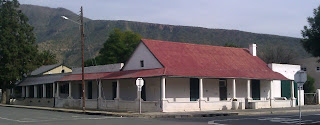Self-renovation has indeed
been in need, and so a late-winter road trip to Cape Town, known as the Cape of
Good Hope in the 17th century, seemed appropriate. A Canadian acquaintance spontaneously agreed
to join me and we hit the road before sunrise for the start of a 3-day, +2400km journey
south.
In Bloemfontein we visited
the Afrikaans Literature Museum, which has a outdatedly-curated quirky collection of beautiful antique writing desks, photographs, paintings, letters and other
memorabilia. Wall biographies of liberals Andre
Brink and Ingrid Jonker are appropriately nestled together in the furthest-away
corner. We also managed to swing a free private
30-minute tour of the Bloemfontein High Court at no notice, after making friends with a
security guard downstairs and avoiding a visitation of Alsatian police
dogs.
Thereafter we took less of a beaten track. A few hours later we arrived in
Richmond, known as the ‘literary jewel of the Karoo’, and for good reason. It’s a two-street village with a church (that
goes without saying for any settlement in the Karoo) and an extensive,
atmospheric second-hand and collectibles bookshop. We zoomed in late on a Friday afternoon,
crossing fingers that we weren’t going to miss out on bookworm time. I couldn't resist another Doris Lessing, this time Martha Quest.
You only need to have a conversation with one resident in the bookshop to ensure that the whole population knows your business in under an hour. Sitting down for dinner at the only restaurant, the manager was quick to say, ‘Oh, I hear you’re from Zimbabwe’. So was he, it turned out. It was low season, so the guesthouses were either closed or virtually empty; we were the sole occupants at ours. We went to grateful sleep that night on crisp sunshine-dried sheets ironed by the coloured women who were gossiping in Afrikaans next door in the kitchen until late.
Another early start the next
morning took us on a smaller road through the Valley of Desolation to
Graaff-Reinet, where the price of a cut-and-colour at the hairdresser is
exactly half of what it costs in the northern suburbs of Johannesburg. Pity I didn’t have time to take up that
opportunity. We visited Reinet House, a
former Dutch Reformed Parsonage dating to 1812, which has a beautiful
mill-house adjoining the back garden. Nearby,
the Old Library museum gives insight into slave histories and charts the life
of anti-apartheid struggle activist Robert Sobukwe, for whom Graaff-Reinet was
home.
Heading into the Eastern
Cape, we made a special diversion to Nieu Bethesda, a settlement established
in 1875 but which only got its first electricity in 1993. We were egged on even further when the local
tourism officer described its main attraction -- the Owl House -- as ‘pretty
weird’. Pretty weird turned out to
probably be the highlight of the journey. Helen Martins, the woman who lived in
and created the Owl House was a recluse, twice divorced in a tiny, conservative
and isolated society where – unimaginably - she had stopped going to church. In her fifties and the '50s, she began
re-creating her living space with crushed coloured glass and gave life to some
300 glass and concrete figurines, including owls, mermaid, wisemen and more. She committed suicide in 1976. It is a fascinating and tragic story, which in part inspired Athol Fugard's Road to Mecca. I’m looking forward to learning more.
From Nieu Bethesda we had a long day’s drive south to Plettenberg Bay, arriving after dark. We tried to take a shortcut from Uniondale to the coast but after about 15 minutes on a bumpy dirt road, I stopped to ask advice from an elderly man who was carefully driving an elderly bakkie behind us. “I don’t want to be a killjoy”, he said in the sincerest fashion, “but I really don’t recommend this route. You’ll damage your car.” And so we had to travel further east first to Jourbertina, adding an extra triangle to our journey.
The popular Garden Route
deserved more time and exploration, but I was surprised at how settled and
developed it is. We dipped our feet
triumphantly in the southern oceans for the first time at Wilderness before heading
through vast fields of yellow canola fields to Hermanus in search of
whales. Sure enough, it only took 20
minutes to glean a some whale-surf sightings, but then it was time to
push on again and get my co-traveller to her flight back to Jozi.
And what thereafter? It’s easy to seclude oneself in the salubrious parts of the southern peninsula and indulge in exploration: in Noordhoek with the Ugg-wearing yogis, where I attended classes taught by a former Israeli Olympic marathoner; in Muizenberg with the walkers and surfers (including the man who’s running 3000km along China’s Mekong River); in Kalk Bay at the cafes and with the artsy-enviromental types. Happiness came in vegetarian food and lemon cupcakes at the Tibetan Teahouse in Simons Town, cycling along Chapman’s Peak on an early spring day in sun-and-blue, the heavenly flourless chocolate cake at the easy-to-miss-apart confectioner’s in Fish Hoek, and hiking around Cape Point surrounded by the extraordinary biodiversity of the fynbos winter flowers.
Ah yes, it can be a bubble
in these parts, broken occasionally by the Zimbabwean immigrants, often easily
identifiable by their name badges in restaurants and shops (there’s only one
country that Learnmore could come from) or by snippets of Shona regularly
overheard. There’s the girl with tears in
her eyes when she talks about home and her mother; the woman who hitches a lift
with me from Scarborough to Masipumelele township; the man who is about to take
his dead brother’s body on the long journey home for burial. This far-end-of-Africa has been a source of Good
Hope for many during uncertain times to the north, and for these few weeks I
guess I am among them.
[With thanks to K. for two photos included here]













No comments:
Post a Comment